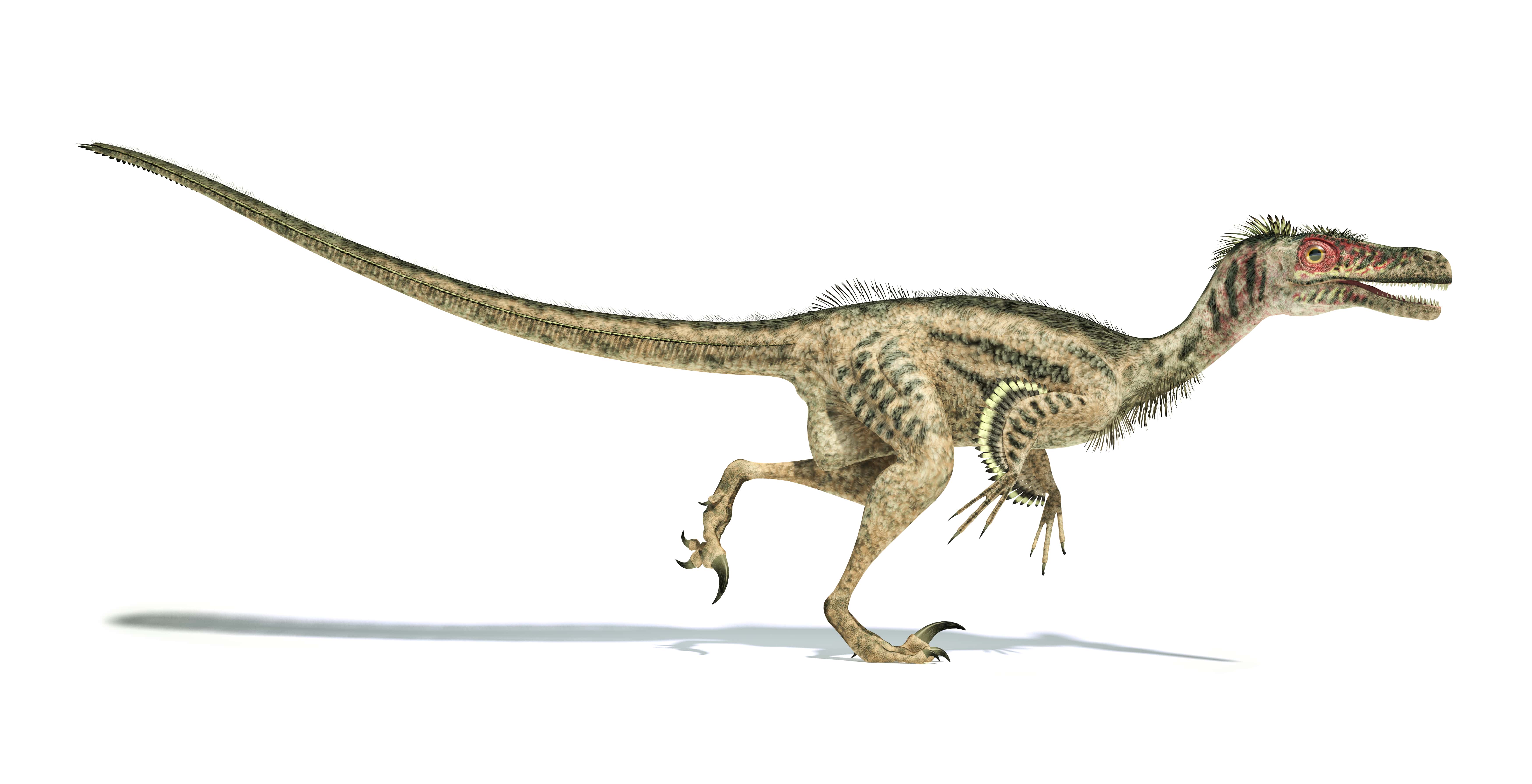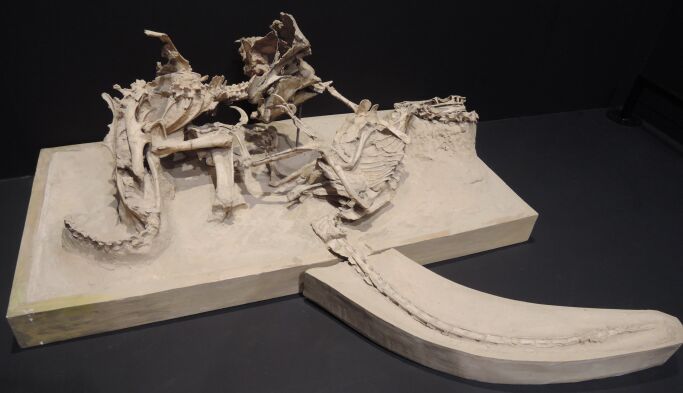
During the first expedition of the American Museum of Natural History in the Gobi Desert (outer Mongolia) in 1923 the first velociraptor fossil.
It consisted of a central and a complete skull, which, however, was unfortunately shattered.
In 1924 Henry Fairfield Osborn, then president of the American Museum of Natural History, gave the fossil the name Velociraptor. The name is composed of VELUX = swift and Raptor = robber or plunderer.
Velociraptor lived in the Cretaceous period about 85.8 million to 70.6 million years ago.
It belongs to the family of Dromaeosauridae. This is a family of small to medium-sized bird-like dinosaurs. Velociraptor was a small dinosaur within this family. An adult Velociraptor grew to be about 2 meters long and only about half a meter tall, comparable to the size of a wolf or turkey.
In later years, more fossils of velociraptors were found in the Gobi Desert, which covers parts of northern China and southern Mongolia. The species Velociraptor mongoliensis was discovered in the Djadochta (Djadokhta) Formation. This is located in the Mongolian province of Ömnögovi .
| Profile | Velociraptor |
|---|---|
| Prehistoric Era | Late Cretaceous 85.2 to 76.4 million years ago |
| Order | Saurischia |
| Suborder | Theropoda |
| Family | Deinonychosauria |
| Tribe | Dromaeosauridae |
| Genus | Velociraptor |
| Species | Velociraptor mongoliensis, Velociraptor osmolskae |
| Height | 0.50 meter |
| Length | 2 meter |
| Weight | 15 kg |
| Territory | Mongolei |
Velociraptor was small and fast. A sickle-shaped claw on its second toe of each foot made it a dangerous predator. He was one of the most bird-like dinosaurs ever discovered. Velociraptor had a special bone in his wrists that allowed him to move his hand sideways in a flapping motion and hold his arm against his body, just as birds do.
Velociraptor became famous from the "Jurassic Park" movies. However, scientists today believe that in reality he did not look even close to how he was depicted in the movies. Neither the appearance nor the size match the fossils found. The makers of the Jurassic Park movies rather modeled it after Deinonychus antirrhopus.
In 2007, paleontologists discovered so-called quill knobs on a well-preserved forearm. In these places the feathers of birds are anchored to the bone. For this reason, scientists concluded that Velociraptor had feathers. However, his arms were too short in relation to his body to be able to fly or glide with them.
It is now believed that the dromaeosaurid ancestors of these dinosaurs were able to fly at an earlier time, but lost this ability over time.
Scientists speculate about the function of its feathers.
Possibly Velociraptor kept its feathers to regulate its body temperature, to protect its brood from the environment, or possibly it used them in courtship.
There is now a strong consensus among paleontologists that today's birds are descended from dinosaurs. The greatest similarities are with the theropod family, a family of 3-toed dinosaurs that includes Tyrannosaurus Rex and Velociraptor.
Similarities:
In birds, the clavicles are fused to form a V-shaped bone, the wishbone ( furcula). The wishbone holds the two shoulder joints apart like a tension spring when flying.
The forked bones were first found in theropod dinosaurs, including Velociraptor.
This is where the assumption comes from that Velociraptor's ancestors were able to fly.
Velociraptor had a relatively large skull with a long, narrow and flat snout, which accounted for about 60% of its total skull length.
It had 13 to 15 teeth in the upper jaw and 14 to 15 in the lower jaw. The teeth were serrated and more pronounced on the posterior edge than on the anterior and were relatively widely spaced.
The bones of its tail were fused together and inflexible. He probably used the tail to maintain balance while running or jumping.
His large front limbs had 3 curved claws.
On each foot, he had a large crescent-shaped claw on the second toe. While running, he kept this toe off the ground. Velociraptor used it as a hook to prevent its prey from escaping; just as can be seen in modern birds of prey. Originally, it was thought that Velociraptor used these claws to slash its prey. Today, however, scientists believe that the dinosaur used them to pierce and fix its prey, much like hawks do, for example.
Velociraptor was a carnivore. Its prey was probably mostly reptiles, amphibians, insects, small dinosaurs and also small mammals.
In 1971, a Polish-Mongolian paleontology team discovered a fossil that became famous:
"Fighting Dinosaurs".

In this fossil, it is easy to see that a Velociraptor had slammed one of its foot claws into the neck of the Protoceratops. The Protoceratops, on the other hand, bit into the Velociraptor's arm, probably breaking it in the process.
Scientists believe that it was unusual for velociraptors to hunt such large prey. Most predators do not attack prey that is more than 50% of their own body mass. This velociraptor was probably starved or just "young and stupid."
However, in 2008, researchers found Protoceratops fossils that had traces of Velociraptor teeth. It is believed that Velociraptor ate carrion from Protoceratops.
Furthermore, researchers assume that this carcass did not contain much meat, which led to the bite marks in the bones.
A large pterosaur bone was found in the guts of a Velociraptor fossil in 2012. It had a wingspan of about 2 meters. Paleontologists believe it is unlikely that the velociraptor killed the pterosaur. Rather, it plundered the carcass.
Velociraptors were effective hunters. They had muscular legs and long shins, which allowed them to take large steps and accelerate to speeds of 40 km/h.
After analyzing the skull, researchers realized that the dinosaur must have possessed a large olfactory bulb. Thus, he had an excellent sense of smell.
In the movie Jurassic Park, velociraptors hunted children in threes.
Scientifically, however, there is no evidence that Velociraptor was a pack hunter.
A 2007 study examining teeth of Deinonychus ( a relative of Velociraptor) found that juveniles ate different foods than adults. Food diversity, however, is atypical in pack hunters.
Velociraptor was probably a nocturnal predator. In him a broad sclerotal ring could be detected, which was wide enough to let in a lot of light. A prerequisite for a higher focal length and thus higher vision in the dark.
Yuya Tamai from Gifu, Japan, CC BY 2.0 https://creativecommons.org/licenses/by/2.0, via Wikimedia Commons
Jens Lallensack, CC BY-SA 4.0 https://creativecommons.org/licenses/by-sa/4.0, via Wikimedia Commons